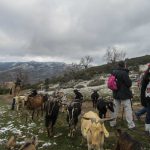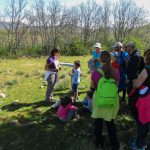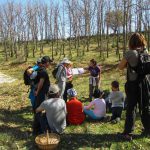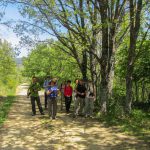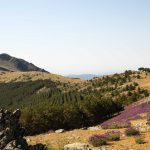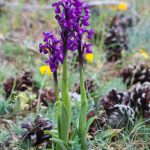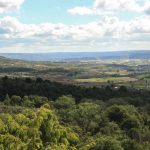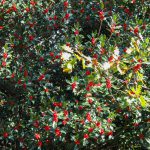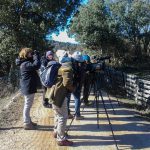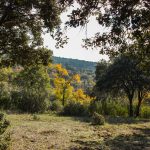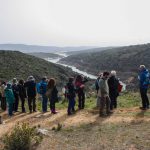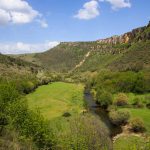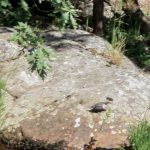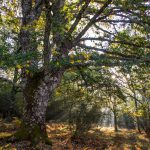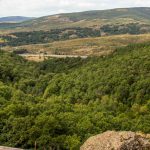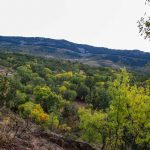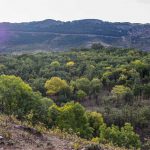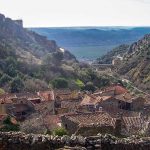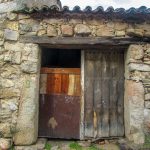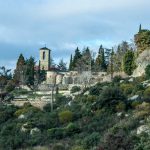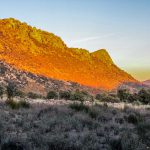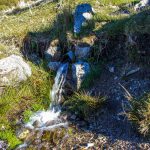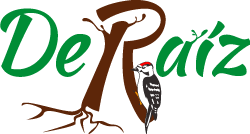
Proyecto: Interpretación Ambiental
Desde la interpretación ambiental trabajamos para:
- Ofrecer al visitante y al habitante una experiencia enriquecedora.
- Impactar en el corazón y crear un vínculo afectivo de los participantes con el lugar.
- Influir en el comportamiento de los destinatarios para favorecer la protección de su patrimonio y de recursos importantes o frágiles.
- Favorecer espacios de encuentro entre visitantes y habitantes cuando tienen inquietudes comunes.
Ofrecemos 4 tipos de recorridos diferentes:
• Paisaje Cultural de la Sierra del Rincón.
• Sendas interpretadas por toda la sierra norte.
• Jornadas culturales.
• Sendas de largo recorrido.
With the environmental interpretation we work:
- To offer the visitors and locals a rewarding experience.
- To touch the heart and create an emotional bond between the participants and the place.
- To influence the behaviour of the participants in order to favour the protection of their heritage and other valuable or fragile resources.
- To facilitate meetings of participants and locals with common interests and concerns.
We offer 4 different types of services:
• Cultural landscape of the Sierra del Rincón.
• Trails around Sierra Norte.
• Cultural events.
• Long distance.
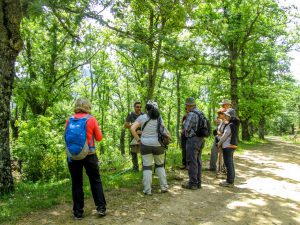
Trabajamos con grupos reducidos, en torno a 15 personas/guía, para ofrecer la mayor calidad posible y una buena comunicación.
We work with small groups, about 15 people per guide, to offer the best quality of attention and communication.

Paisaje cultural de la Reserva de la Biosfera de la Sierra del Rincón.
/
Cultural landscape of the Sierra del Rincón Biosphere Reserve
La Sierra del Rincón, un territorio a caballo entre la Sierra de Guadarrama y la Sierra de Ayllón, dónde se respira la armonía de la naturaleza y los usos de la población local. Declarada Reserva de la Biosfera en el año 2005, como reconocimiento a un territorio que mantiene su identidad, con grandes valores ecológicos.
The Sierra del Rincón, a mountain range located between the Sierra de Guadarrama and the Sierra de Ayllón, is a place where the local people live in harmony with the nature. It was declare Biosphere Reserve in 2005, in view of its preserved identity with strong ecological values.
Senda guiada por una educadora ambiental y una pastora en la que los participantes conocen los valores naturales y culturales del valle de La Puebla.
Esta actividad se enmarca en un territorio dónde la cultura pastoril conoce, entiende y conserva la naturaleza. También conoceremos como el paisaje que hoy nos rodea es el resultado de la fusión entre la naturaleza y la vida de las poblaciones locales.
La distancia recorrida y los lugares por los que se transita vienen determinados por el ciclo anual del rebaño y la meteorología. Por el bienestar del rebaño, y dado que el rebaño va acompañado por sus perros no es posible realizar la senda con perros.
Accesible en mochila portabebés (sesión de tarde)
Lugar: Puebla de la Sierra.
Walk guided by an environmental educator profesional and a shepherdess. The participants learn about nature and culture values of the La Puebla Valley.
This activity takes place in a territory where the pastoral culture knows, understands and preserves the nature. We will understand how the current landscape surrounding us is the result of the fusion of nature with the life of local communities.
The length of the walk and exact path is determined by the annual cycle of the flock and the weather. For the sake of the flock, and because it is always accompanied by shepherd dogs, this activity is not suitable for dogs.
Accessible with backpack baby carrier (afternoon session).
Place: Puebla de la Sierra.
Senda intergeneracional para mantener viva la tradición oral en la Naturaleza, dónde nuestros pasos nos harán sentir la “cultura que hace el paisaje”.
La cultura pastoril de la Sierra del Rincón, en concreto en Prádena del Rincón ha estado vinculada a la trashumancia, ese manejo de ganado relacionado con las estaciones del año ha enriquecido la diversidad natural y cultural de la Península Ibérica.
El patrimonio inmaterial de la Sierra del Rincón cobrará vida a través de romances, cuentos y tradición oral relacionada con el oficio de pastor. El recorrido nos dará la oportunidad de conocer los paisajes de la Sierra del Rincón, de la vegetación, de la fauna que la habita, los usos del territorio…
Accesible en mochila portabebés.
Lugar: Prádena del Rincón.
Intergenerational walk to keep alive the oral tradition in the Nature, where our steps will convey the “culture brought by the landscape”.
The pastoral culture of the Sierra del Rincón, specifically in Prádena del Rincón village, has been linked to the transhumance, the managing of livestock depending on the seasons has enriched the natural and cultural of the Iberian Peninsula.
The intangible heritage of the Sierra del Rincón is brought to life though the romances, tales and oral tradition related to the pastoral occupation. The walk will provide us the opportunity to know the landscapes of the Sierra del Rincón, the vegetation and the fauna living there, the uses of the territory…
Accessible with backpack baby carrier.
Place: Prádena del Rincón.
Senda circular por la dehesa de La Hiruela, una dehesa dentro de la región mediterránea que alberga a su vez especies botánicas con mayores requerimientos de humedad (influencia eurosiberiana). Reconoceremos los usos del paisaje y de las especies botánicas principales.
Dehesas serranas, almacén de recursos y biodiversidad.
Lugar: La Hiruela
Circular walk through the pasture of La Hiruela, a mediterranean pasture harbouring botanical species that require higher humidity (Eurosiberian Atlantic influence). We will recognise the uses of the landscape and of the principal botanical species.
Mountain pastures, resources and biodiversity store.
Place: La Hiruela.
Es una senda ornitológica para recorrer el valle de Horcajuelo de la Sierra, al norte de la comunidad de Madrid y al pie de los cordales montañosos de Somosierra y Sierra Escalba. Un lugar privilegiado en la transición entre la Sierra de Guadarrama y la Sierra de Ayllón.
El recorrido abarcará distintos ecosistemas con objeto de avistar distintas especies de aves. Desde los robledales montanos de roble melojo, a las alisedas pasando por cantuesares-tomillares y mosaicos agropecuarios formados por antiguos linares, huertas y prados.
Nuestro objetivo será la observación de aves y también prestaremos atención a otros indicios de fauna.
Lugar: Horcajuelo de la Sierra.
This is a bird watching walk through the Horcajuelo de la Sierra valley, North of the Comunidad de Madrid and at the bottom of the mountain ranges of Somosierra and Sierra Escalba. A privileged site in the transition area between Sierra de Guadarrama and Sierra de Ayllón.
This path encounters different ecosystems with the purpose of watching different bird species. From the oak grove of Pyrenean oak (Quercus pyrenaica, roble melojo), to the alder grove (Alnus glutinosa, aliso), through the Spanish lavander and thymus fields and agricultural and livestock mosaics consisted of old linen fields, vegetable gardens and meadows.
Our main purpose will be the bird watching, but we will also pay attention to other fauna signs.
Place: Horcajuelo de la Sierra.
Ruta semi-circular para ascender al Pico de Peña La Cabra uno de los más emblemáticos de la Sierra del Rincón; desde el cual se tienen amplias vistas de: las Sierra de Guadarrama y Somosierra, la Sierra del Rincón y la Sierra de Ayllón.
A lo largo del recorrido podremos conocer más sobre la Flora, Fauna y la Geología del entorno, las adaptaciones a la alta montaña; así como los usos del territorio que han modelado el paisaje que hoy vemos.
Semi-circular walk for the ascent to Peak of Peña La Cabra, one of the most emblematic peaks of Sierra del Rincón, from which we can contemplate ample views of: Sierra de Guadarrama y Somosierra, Sierra del Rincón and Sierra de Ayllón.
Throughout the path we will learn more about the flora, fauna and geology of this site, the adaptation to high-altitude, as well as the uses of the territory that have shape the landscape to what we can see nowadays.
Ruta Circular que une Prádena del Rincón, Horcajuelo de la Sierra y Montejo, utilizando vías pecuarias, caminos vecinales y preciosas callejas entre muretes de piedra seca. En el recorrido podremos disfrutar del bosque de ribera, los prados de diente y de siega, antiguos linares hoy huertas, regueras, matorrales muy aclarados, bosquetes de robles. Nos centraremos en descifrar el paisaje y conocer los usos del territorio.
Accesible en mochila portabebés.
Circular walk through Prádena del Rincón, Horcajuelo de la Sierra, and Montejo, using livestock routes, rural roads and narrow streets between walls of dry stone. The path gives us the chance to enjoy the riverbank wooded area, the grazing and harvest meadows, old linen fields today transformed into vegetable gardens, traditional irrigation channels, very lighten brushwood, and oak copses. We will focus on deciphering the landscape and get to know the uses of the territory.
Accessible with backpack baby carrier.

Sendas por la Sierra Norte / Trails around Sierra Norte
Ofrecemos distintas sendas dentro de la comarca, cuya temática central puede ser la Ornitología o desde la Interpretación Ambiental.
We offer different trails across the region, with Ornithological or Environmental interpretation themes.
Recorrido lineal accesible para personas con movilidad reducida y carritos de bebé. Atraviesa la dehesa boyal de Redueña, siguiendo uno de los caminos de servicio del Canal de Isabel II. La dehesa se encuentra situada en la rampa, entre la sierra y la campiña.
Las especies principales de la dehesa son encinas y quejigos y otras acompañantes como arce de Montpellier, enebro de la Miera, higueras, retama, majuelos, jara pringosa, jara estepa… y un colorido cortejo florístico en primavera.
Lugar: Redueña.
Linear trail accessible for disabled people and baby buggies. Linear route through the communal pastures of Redueña, following one of the service roads of the Canal de Isabel II. The pastures are in between the mountains and the countryside.
The main plant species in the pastures are the holm oaks and the Portuguese oaks, together with other species such as Montpellier maples, prickly junipers, figs, broom bushes, gum rockrose, laurel-leaved rock rose … and full of colourful flowers during spring.
Place: Redueña.
Las acebedas proporcionan refugio y alimento para las aves en invierno, descanso y frescor para el ganado en verano; adentrarse en el interior de los bosquetes de acebos transformará sin duda nuestra percepción del paisaje serrano.
En esta senda conoceremos uno de los bosquetes de mayor singularidad de la Comunidad de Madrid, muestra y reducto de las especies vegetales que cubrían la zona en tiempos ancestrales y que debe su conservación y su peculiar fisionomía al hacer de sus gentes.
Lugar: Robregordo.
Holly trees provide cover and food for birds during winter, and shadow and freshness for the livestock during summer. Without any doubt, getting inside the holly trees copses will transform our perception of the mountain landscape.
In this walk well get to know one of the copses of more singularity in the Comunidad de Madrid, bastion and proof of the plant species that covered the area in ancient times and which owes its conservation and shape to the local practices.
Place: Robregordo.
El embalse de Pedrezuela se encuentra en la fosa de Guadalix, que alcanza su máxima profundidad en el embalse con 828 m, y recibe la entrada del río Guadalix de forma muy somera.
Este embalse recibe los pasos migratorios de los bandos de aves que cuando cruzan la Sierra se encuentran con el embalse y a su vez el río Guadalix actúa como corredor ecológico para las aves paseriformes.
Lugar: Guadalix de la Sierra
The Pedrezuela reservoir is located in the tectonic pit of Guadalix, which reaches its maximum depth in the reservoir at 828 m (more than 2700 feet), and receives the waters from Guadalix river in a very shallow position.
This reservoir welcome flocks of migratory birds that when crossing the mountain range find the reservoir and the Guadalix river, serving as a green corridor for the passerines.
Place: Guadalix de la Sierra.
Desde Serrada de la Fuente, uno de los pueblos que mejor conserva la arquitectura tradicional serrana en el entramado de sus calles y construcciones, iniciaremos esta senda rumbo al embalse del Villar.
Este recorrido nos llevará entre distintos ecosistemas, desde los encinares acompañados de jara pringosa y romero, encinares mixtos con pinos resinero, hasta repoblaciones de pino resinero y quejigares. La vegetación de ribera estará presente al atravesar varios arroyos.
Lugar: Serrada de la Fuente.
From Serrada de la Fuente, one of the villages with better preservation of the traditional mountain village architecture with its streets and buildings structure, we will start this walk to the Villar reservoir.
This path will get us through different ecosystems, from the holm oak woods with gum rockrose and rosemary, through the mixed woods of holm oak and cluster pines, to the reforestation woods of cluster pines and Portuguese oaks. The riverside plants will be present when crossing various steams.
Place: Serrada de la Fuente.
Siguiendo las aguas del Río Madarquillos iremos descubriendo su bosque de ribera y las especies que lo habitan. Dejaremos que el río nos cuente historias sobre las gentes que han pescado en sus aguas, los ganados que pastan en las cercanías y la frenética actividad que había en torno a los molinos.
Recorreremos el curso del Madarquillos, a su paso por Madarcos, en las estribaciones de las sierras de Somosierra y situado en un cerro sobre el cauce fluvial.
En una zona de suaves pendientes, dónde podremos disfrutar del bosque de ribera y del mosaico de ecosistemas circundantes: con matorrales aclarados, encinares, pastizales herbáceos, fresnedas y melojares muy aclarados por los aprovechamientos tradicionales del territorio. Conoceremos la evolución de estos ecosistemas en el momento actual.
Lugar: Madarcos.
Following the waters of River Madarquillos we will discover its river forest and the species living in it. Along the path we will let the river tell us old stories about the locals that were fishing in its waters, the livestock grazing nearby, and the frenetic activity around the mills.
We will walk along the River Madarquillos as it passes through Madarcos, a village in the foothills of Somosierra on a hill above the river.
The area has slight slopes where we will enjoy the river forest and the mosaic of ecosystems around: with lighten brushwood, Holm oak woods, grasslands, ash woods and Pyrenean oak groves (very lighten by the traditional uses of the territory). We will get to know the evolution of these ecosystems nowadays.
Place: Madarcos.
Remontando el Río Lozoya entre la presa del Pontón de la Oliva y la presa de la Parra nos adentraremos en un valle de contrastes. Entre pizarras y calizas; entre matorral mediterráneo y bosque de ribera; los cortados calizos, las fresnedas adehesadas y el pinar de repoblación.
Esta variedad de paisajes, acoge gran variedad de aves: Cortados para chovas piquirrojas, halcón peregrino, algún águila real, búho real; el matorral mediterráneo para colirrojos tizones, trigueros, escribanos montesinos…; el bosque de ribera para herrerillos, agateadores, chochines, autillos…; el río para cormoranes, ánades, garzas…
Lugar: Patones.
Ranging up the course of Lozoya River, between the reservoirs of Pontón de la Oliva and Parra, we will go deep into a valley full of contrasts: slates and limestones, mediterranean brushwood and riverbank forest, the limestone river cliffs, the cleared ash woods and the repopulation pines.
All this variety of landscapes includes a great variety of birds: the river cliffs host the red-billed choughs, the peregrine falcon, some golden eagle, Eurasian eagle-owl…; the mediterranean brushwood is for the black redstarts, the corn buntings, the rock buntings…; the riverbank forest for the blue tits, short-toed treecreepers, wrens, scops owls…; the river for cormorants, ducks, herons…
Place: Patones.
El río Lozoya, eje vertebrador de la Sierra Norte madrileña, nos guiará por su valle permitiéndonos conocer la avifauna que lo habita.
Este recorridos nos llevará entre el bosque de ribera, las praderas salpicadas de fresnos, robledales y zonas de matorral mediterráneo aclarado salpicado de encinas, enebros y alguna sabina. En la Sierra de Guadarrama, protegidos por los Montes Carpetanos y la Sierra del Hontanar.
Lugar: Lozoya del Valle.
Lozoya River, the spinal cord of the Sierra Norte of Madrid, will guide us through its valley.
This path will bring as through the riverbank forest, the grasslands with some ashes, oaks and areas of Mediterranean brushwood, in the Sierra de Guadarrama, protected by the Montes Carpetanos and the mountain range of Sierra del Hontanar.
Place: Lozoya del Valle.
Las aguas recogidas de las laderas de la Cuerda Larga y del macizo de Peñalara, dibujan el paisaje del Valle Alto del Lozoya, y es un recurso natural fundamental para abastecer de agua a sus habitantes, a la ganadería, proporcionando a su vez refugio a la fauna.
Los bosques de melojo y los pinares albares, junto con sus aprovechamientos forestales pasados y presentes, hacen que en Valle del Paular se observe “una inversión botánica” y el pino albar crezca a menor cota que el robledal.
Lugar: Rascafría.
The water collected from the hill sides of the Cuerda Larga and Peñalara Mountains define the landscape of Valle Alto del Lozoya (Lozoya High Valley). It is a fundamental resource providing the water to the locals and the livestock, and shelter for the fauna.
The Pyrenean oak woods and Scots pines woods, due to their past and current forest exploitation, produce a “botanical inversion” at the Paular Valley where we can observe the Scot pines growing at lower altitude than the Pyrenean oaks.
Place: Rascafría.
Este recorrido por los pinares albares de la Sierra de Guadarrama esconde tesoros botánicos no habituales dentro de la región mediterránea: Tejos, abedules, acebos…
Ecosistemas forestales relícticos, propios de clima templado-húmedo, más suave que el actual y han quedado relegados a laderas de umbría y al nacimiento de los arroyos y se agradece su frescor en época estival.
Lugar: Canencia de la Sierra.
This path across the Scots pines woods of the Sierra de Guadarrama hides some botanical treasures uncommon in the mediterranean region: European yews (Taxus baccata), birches (Betula sp.), hollies (Ilex aquifolium)…
These relict forest ecosystems, typical of temperate-humid climate softer than the current climate, have remain relegated to the shade slopes and to the creeks birth. We appreciate their freshness during the summer season.
Place: Canencia de la Sierra.
La región madrileña alberga en Somosierra, la sierra del Rincón y el Valle Alto del Lozoya algunos reductos de bosques propios de la cordillera cantábrica, propios de climas templado-húmedos, que tienen alto interés biogeográfico.
Nos adentraremos en un ecosistema forestal entre abedules, avellanos, robles, serbales, mostajos…en un territorio dónde el manejo comunal de la dehesa les ha permitido escapar históricamente a la deforestación. Tradicionalmente se han realizado aprovechamientos forestales y ganaderos muy vinculados a la población local.
Lugar: Somosierra.
The region of Madrid presents in Somosierra, la Sierra del Rincón and the High Valley of Lozoya, some redoubt of forests with high biogeographical interest for being typical of temperate-humid climate and common in the Cordillera Cantábrica (in the North of Spain).
We will enter a forest ecosystem of birches, hazels, oaks, rowans or mountain ashes, whitebeams … in a territory where the communal exploitation of the “dehesa” has allowed those trees to avoid the deforestation across the time. Traditionally, the “dehesa” is a communal property used for agroforestry related to the local population.
Place: Somosierra.
Las vías pecuarias funcionan como corredores ecológicos que han permitido el aprovechamiento de los recursos naturales de forma óptima por parte del ganado lanar. Imitan las migraciones de los herbívoros silvestres en busca de alimento. Además este tránsito de ganado estaba íntimamente ligado al comercio de la lana que fue pieza fundamental en la economía española durante siglos.
Encontraremos un paisaje muy relacionado con la ganadería de la zona, pasada y presente; así como arquitectura rural relacionada con este oficio.
Lugar: Prádena del Rincón.
Livestock tracks serve as green corridors that have allowed the optimal exploitation of natural resources by the woolgrowers. Livestock movements mimic the migration of wild herbivores in search of food. Furthermore, this seasonal movement of livestock is closely connected with the wool trade, an essential part of the Spanish economy for centuries.
We will find a landscape linked to the livestock breeding activity of the region, past and present, as well as the corresponding rural architecture.
Place: Prádena del Rincón.
Este recorrido nos llevará entre distintos ecosistemas: desde los barrancos calizos, antiguas huertas, arroyos, el contraste entre las pizarras y las calizas con el matorral asociado a cada sustrato y la panorámica de la vega del Jarama.
Sin olvidarse del valor etnográfico del pueblo de Patones de Arriba y el valor histórico de las infraestructuras del Canal de Isabel II (almenaras, sifones, acueductos…) para el abastecimiento de agua.
Lugar: Patones.
This walk will bring us through different ecosystems: limestone river cliffs, old vegetable gardens, creeks, the contrast between the slates and limestones substrata and the brushes associated to each one, and the panoramic view of the fertile plane of the Jarama river.
Not to forget the ethnographical value of the village of Patones de Arriba and the historical value of the infrastructures of the Canal de Isabel II (beacons, siphoned, aqueducts…) for the water supply.
Place: Patones.
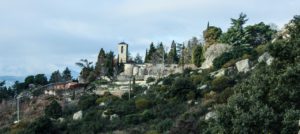
Jornadas Culturales / Cultural events
Estas jornadas discurren por los alrededores de El Berrueco o La Cabrera, donde poder admirar el modo de vida, la cultura y la gastronomía de la zona.
These days travel around the Berrueco or La Cabrera, where you can admire the way of life, culture and gastronomy of the area.
El Berrueco es un pueblo situado en la Sierra Norte de Madrid, entre la prolongación este de la Sierra de La Cabrera y el embalse del Atazar. El origen del nombre del pueblo, parece que se debe al cerro de granito que se sitúa al norte del municipio ya que el significado de berrueco es “peñasco rocoso”. Su asentamiento está datado de los siglos X y XI. Aunque hay indicios de posibles asentamientos anteriores, dado que se conserva un puente romano en la linde con Sieteiglesias en una vía pecuaria que debió ser calzada romana para conectar Complutum (Alcalá de Henares) con Duratón (Segovia) a través del puerto de Somosierra.
Existe otra teoría sobre la etimología de El Berrueco, se cita a finales del siglo XV pero deriva de la forma medieval Barroco, “barriuco, barrio pequeño”. Del árabe barr, “periférico exterior” se originó la palabra barrio, “casas fundadas en el campo, fuera de la población principal”. A ella los pobladores cantábricos, con un gran sustrato celta en su habla, añadieron el sufijo –oko, actualmente frecuente en Cantabria (la praderuca, la peñuca…) (Fuente Siguero Llorente,P.L (2009) Significado de los nombres de los pueblos y despoblados de Madrid. Ed. Bercimuel)
La jornada incluye:
- Conocer su dehesa boyal y sus usos tradicionales.
- Visita al Museo de la Cantería (al aire libre)
- Visita a la presa del Villar.
- Comida en algún restaurante de la zona.
- Concierto de música tradicional “¡Qué siga sonando!” (en la sobremesa)
- Gestión del almuerzo en un restaurante del pueblo, si se quiere.
El Berrueco is a village located in the Sierra Norte de Madrid, between the East extension of the Sierra de La Cabrera and the Atazar reservoir. Apparently, the origin of the village’s name comes from the granite cliff at the North of the of the municipality, because “berrueco” means “rocky cliff”. Its settlement dates back to the 10th-11th centuries. However, there are signs of previous possible settlements, such as the roman bridge on the boundary with Sieteiglesias, in a livestock track that most probably was a roman road connecting Complutum (Alcalá de Henares) with Duratón (Segovia) through the mountain pass of Somosierra.
There is another theory about the etymology of El Berrueco, from the end of the 15th century as a derivative of the medieval word “Baroque” (Barroco), that means “barriucu, small neighbourhood”. The word “barrio” (meaning “countryside houses outside the main population centre”) comes from the Arabic barr, “external periphery”. The Cantabrian people, with the celtic roots of their speech, added the suffix “-oko”, currently used very often in Cantabria (la pedruca, la peñuca…) (Reference Siguero Llorente, P.L (2009) Significado de los nombres de los pueblos y despoblados de Madrid. Ed Bercimuel).
The journey includes:
- Getting to know its “dehesa boyal” (the communal meadow of the village) with its traditional uses.
- Visit to the open air museum of the Stonework (Cantería)
- Visit to the Villar reservoir.
- Lunch in a local restaurant.
- Traditional music concert: “¡Que siga sonando!” (Keep the music playing!) (after lunch at the restaurant)
- Small breakfast at a restaurant of the village, if desired.
La Sierra de La Cabrera da la bienvenida a todos los visitantes de la Sierra Norte, y ofrece un rico y variado patrimonio geológico, arqueológico y cultural ligado a la roca granítica. Esta jornada quiere introducir al visitante en los valores naturales y culturales más representativos del pueblo y cómo la actividad humana estaba integrada en el medio.
La jornada incluye:
- Conocer las dehesas boyales y sus usos tradicionales.
- Visita al Convento de San Antonio y San Julián.
- Taller a elegir: Demostración de Cantería o Taller de elaboración de pan.
- Comida en el Huerto de San Antonio.
- Gestión del almuerzo en un restaurante del pueblo, si se quiere.
The Sierra de La Cabrera welcomes all Sierra Norte visitors, and offers a rich and variate geological, architectural and cultural heritage connected to the granite rock. This session aims to introduce the visitor to the village most representative cultural and natural values, and to show how the human activity was integrated in the environment.
The session includes:
- Get to know the “dehesas boyales” (communal property used for agroforestry) and their traditional uses.
- Visit the nunnery of San Antonio y San Julián.
- Workshop (two options): Stonework demonstration or Bread baking workshop.
- Lunch at Huerto de San Antonio.
- Small breakfast at a restaurant of the village, if desired.

Largo recorrido / Long distance
Sendas guiadas de largo recorrido. Estas sendas no las hacemos solo para hacer deporte, sino también para poder interpretar el entorno en el que nos moveremos.
Long distance guided tours. This walks are not only to exercise, but to interpret the environment along the path.
Este sendero de Gran recorrido (GR 300) que rodea al embalse del Atazar y conecta los pueblos ribereños del embalse por caminos tradicionales, vías pecuarias y caminos de servicio del Canal de Isabel II nos adentrará en el paisaje de esta zona.
Se puede realizar toda la senda por etapas o alguna de las etapas de la misma dado que tienen distinto grado de dificultad y valores naturales y culturales.
This walk belonging to the GR footpath (Gran Recorrido, GR300), that surround the Atazar reservoir and connects the villages around the reservoir through traditional pathways, livestock paths and service roads of the Canal de Isabel II, will bring us deep into the landscape of this area.
This walk can be achieved in several stages at once, or choose one or some stages depending on the difficulty and the natural and cultural values of the different stages.



